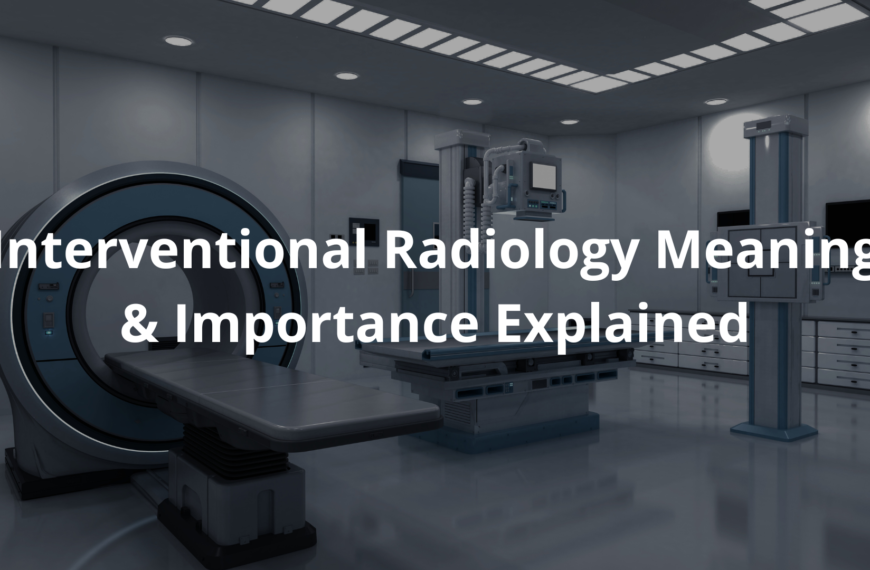Get to know about interventional radiologists and how they use advanced imaging to help patients with various medical conditions.
Interventional radiologists are a bit like body detectives, piecing together clues from detailed images like CT scans and MRIs. They don’t need to make big cuts to solve medical mysteries—just tiny tools and precise techniques. This means patients can heal faster, with less pain and shorter hospital stays.
From treating blocked blood vessels to fighting cancer with pinpoint accuracy, their work is both fascinating and life-changing. It’s a mix of science, skill, and care that often goes unnoticed. Want to know how they do it and why their work matters so much? Keep reading to uncover their incredible impact!
Key Takeaway
- Interventional radiologists use imaging to carry out procedures that help treat patients.
- They have to go through many years of training to become specialists.
- Their work helps patients recover faster with less pain.
What Do Interventional Radiologists Do?
Interventional radiologists (IRs) are doctors who use imaging tools like CT scans, ultrasounds, and X-rays to perform procedures that treat a variety of health problems. They’re kind of like detectives with high-tech gadgets, finding and fixing issues inside the body without needing big surgeries.
For example, if someone has a blood clot in a large vein, an interventional radiologist might use a tiny tube called a catheter to reach the clot. They can then dissolve it to restore blood flow. They do this while watching everything on a screen in real-time, which helps them be super precise.
Most people don’t realise how much these doctors can do. They treat all sorts of conditions—like liver cancer, kidney stones, or blocked blood vessels—using their skills and advanced tools. One common procedure is a guided biopsy, where they take a small bit of tissue to check for cancer or other problems. They use imaging to guide them to the exact spot, kind of like following a GPS to find a hidden treasure.
Procedures They Perform
Here are some of the most common procedures interventional radiologists do:
- Guided Biopsy: Taking a small tissue sample from a suspicious lump or area.
- Biliary Drainage: Helping drain bile from the liver when it’s blocked.
- Stent Placement: Putting in a small tube to keep blood vessels open.
- Embolisation: Blocking a blood vessel to stop bleeding or shrink tumours. [1]
These procedures are usually quicker than traditional surgeries, which means patients often recover faster. Sometimes, they can even go home the same day. That’s a big deal for people who don’t want to spend days in a hospital bed.
But it’s not all easy. Interventional radiologists have to be very careful. For instance, if they’re treating a varicose vein, they need to avoid damaging nearby blood vessels. Their training and experience help them handle these tricky situations.
Training to Become an Interventional Radiologist
Becoming an interventional radiologist in Australia takes years of hard work and study. Here’s a simple breakdown of the steps:
- Medical Degree: Study for 5-6 years to become a doctor.
- Internship: Spend one year getting hands-on experience in a hospital.
- Residency: Work for at least one year in a related specialty area.
- Specialty Training: Train for five more years in clinical radiology to become a fellow.
- Subspecialty Training: Spend at least one extra year learning specifically about interventional radiology. [2]
It’s a long road, but it’s worth it. During their training, they learn about blood flow, how to use imaging tools like CT scans, and the best ways to treat different conditions. They also learn how to keep patients calm and comfortable, which is just as important as the technical stuff.
Imagine being able to help someone with a blocked bile duct feel better in just a few hours. That’s the kind of difference interventional radiologists can make, and it’s what drives many of them to work so hard.
Importance of Interventional Radiologists
Interventional radiologists are a key part of modern healthcare. They offer treatments that are less invasive than traditional surgeries, which means shorter recovery times and fewer risks for patients.
They also work closely with other specialists, like oncologists and surgeons, to make sure patients get the best care. For example, if someone has lung cancer, an interventional radiologist might help by performing a biopsy or placing a stent to improve breathing. This teamwork ensures patients get a well-rounded treatment plan.
By using minimally invasive techniques, interventional radiologists help patients avoid big surgeries. This approach often leads to better outcomes, faster recovery, and less time spent in the hospital.
Safety and Guidelines
Many patients feel nervous about medical procedures, and interventional radiologists get that. They focus on safety by using the best equipment and following strict guidelines set by organisations like the Royal Australian and New Zealand College of Radiologists (RANZCR).
Here’s how they prioritise safety:
- Radiation Safety: They carefully manage the use of radiation, making sure the benefits of a procedure outweigh any risks. They also explain to patients how imaging helps them perform procedures accurately.
- High-Quality Equipment: They use advanced imaging machines that are regularly checked and calibrated to ensure they work properly.
Safety and precision are at the heart of what interventional radiologists do. They want every patient to feel confident and cared for.
Future of Interventional Radiology

The need for interventional radiologists is growing, especially as more people develop chronic conditions like artery disease. There are job opportunities in hospitals, private clinics, and specialised centres across Australia.
As technology improves, interventional radiologists will have even better tools to help patients. Smaller catheters, clearer imaging, and maybe even robots could make procedures safer and more effective.
It’s exciting to think about what’s ahead. Interventional radiologists will keep finding new ways to treat patients and improve lives. If you ever need one, you’ll know you’re in good hands.
FAQ
How do interventional radiologists see inside my body during procedures?
They use medical imaging and image guidance to see inside the human body in real time. It’s like having a special camera that lets them watch what they’re doing on a screen while they work. They use ct guidance too, which helps them work very carefully.
How do they fix problems with blood vessels and blood clots?
They’re experts at treating blood clots, vascular disease, and problems in blood vessels like the vena cava, portal vein, and carotid artery. They can put in an ivc filter (a tiny safety net) to catch dangerous clots. They also help fix dilated veins and varicose veins that cause trouble.
What makes their procedures different from regular surgery?
Instead of open surgery, they use a small catheter (a tiny tube) to do their work. They can fix bile ducts, put in stents, and treat things like uterine fibroids through vascular access points. The best bit? The recovery time is usually much shorter than regular surgery.
How do they help treat cancer and pain?
Using a fine needle and special tools, they can take a tissue sample or do thermal ablation to treat cancer. They work alongside radiation therapy teams and help with pain management by treating nerve root problems. They can even control blood supply to specific spots using embolic agents.
What training do they need in North America and the United States?
They go through a special training program called an ir residency after medical school. A task force from the american board makes sure they know about patient care and all sorts of ir procedures. It’s a medical specialty that needs lots of practice ir experience.
How do they treat problems with arteries?
They use ct angiography to look at arterial disease and can fix problems in the uterine artery and do prostate artery procedures. They have a wide range of tools to fix blood flow problems. They also check for any side effects and handle post procedural care.
How do they fix bleeding problems in veins?
Using imaging guidance, they can stop variceal bleeding and fix up problematic veins. They’re careful about the risk of rupture and use special techniques to help. They handle venous access too, including putting in central venous lines when needed.
What different procedures do they do?
They do a wide variety of jobs – from needle aspiration to main content blood vessel work. They might help with biliary drainage one day and nuclear medicine procedures the next. They work closely with other doctors in university press hospitals across Australia to give the best possible care.
Conclusion
Interventional radiologists in Australia are key to healthcare, treating many conditions with minimally invasive methods. Their training and dedication make them crucial in medicine. If you ever need a procedure, you might meet one.
They’re not just doctors; they’re problem-solvers with imaging tools, guiding treatments with precision. From unblocking arteries to treating tumours, their work often replaces major surgeries. They’re the kind of specialists who quietly save lives, one patient at a time.
References
- https://irsa.com.au/what-is-interventional-radiology/
- https://www.ranzcr.com/fellows/clinical-radiology/professional-documents/standards-of-practice-for-interventional-radiology-and-interventional-neuroradiology




